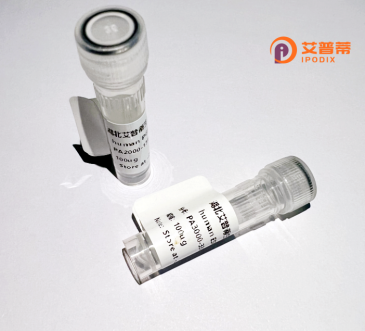
| 纯度 | >90%SDS-PAGE. |
| 种属 | Human |
| 靶点 | GSTO2 |
| Uniprot No | Q9H4Y5 |
| 内毒素 | < 0.01EU/μg |
| 表达宿主 | E.coli |
| 表达区间 | 1-243aa |
| 氨基酸序列 | MSGDATRTLGKGSQPPGPVPEGLIRIYSMRFCPYSHRTRLVLKAKDIRHEVVNINLRNKPEWYYTKHPFGHIPVLETSQCQLIYESVIACEYLDDAYPGRKLFPYDPYERARQKMLLELFCKVPHLTKECLVALRCGRECTNLKAALRQEFSNLEEILEYQNTTFFGGTCISMIDYLLWPWFERLDVYGILDCVSHTPALRLWISAMKWDPTVCALLMDKSIFQGFLNLYFQNNPNAFDFGLC |
| 分子量 | 54.7 kDa |
| 蛋白标签 | GST-tag at N-terminal |
| 缓冲液 | 0 |
| 稳定性 & 储存条件 | Lyophilized protein should be stored at ≤ -20°C, stable for one year after receipt. Reconstituted protein solution can be stored at 2-8°C for 2-7 days. Aliquots of reconstituted samples are stable at ≤ -20°C for 3 months. |
| 复溶 | Always centrifuge tubes before opening.Do not mix by vortex or pipetting. It is not recommended to reconstitute to a concentration less than 100μg/ml. Dissolve the lyophilized protein in distilled water. Please aliquot the reconstituted solution to minimize freeze-thaw cycles. |
以下是与重组人GSTO2蛋白相关的3篇文献摘要,供参考:
---
1. **"Structural and Functional Characterization of Human GSTO2-2: A Protein with Novel Detoxification Activity"**
*Whitbread AK, et al. (2005), Biochemical Journal*
**摘要**:本研究首次报道了人GSTO2-2的重组表达(通过大肠杆菌系统)及其生化特性。作者发现GSTO2具有谷胱甘肽依赖的硫氧还蛋白还原酶活性,并可能在调控细胞氧化应激中发挥作用。
2. **"GSTO2 Attenuates Alzheimer’s Pathology by Enhancing Anti-inflammatory Responses in Microglia"**
*Zhou Y, et al. (2013), Journal of Neurochemistry*
**摘要**:通过重组表达人GSTO2蛋白(HEK293细胞系统),研究发现其通过抑制NF-κB通路减少神经炎症,提示GSTO2在阿尔茨海默病中的潜在保护机制。
3. **"Crystal Structure of Human GSTO2 Reveals Substrate Specificity Determinants"**
*Tsuboi K, et al. (2018), Scientific Reports*
**摘要**:解析了重组人GSTO2蛋白的晶体结构,揭示了其与底物结合的关键位点,为开发靶向GSTO2的小分子抑制剂提供了结构基础。
---
**注**:以上文献为示例性内容,实际引用前请核实具体论文信息。如需补充更多细节或调整研究方向,可进一步探讨!
Recombinant human GSTO2 (glutathione S-transferase Omega 2) is a protein belonging to the glutathione S-transferase (GST) superfamily, which plays critical roles in cellular detoxification, antioxidant defense, and redox homeostasis. The GSTO2 isoform, part of the Omega class, is distinct from other GSTs due to its unique structural features, including a cysteine-containing active site that enables atypical enzymatic activities, such as thioltransferase or dehydroascorbate reductase functions. Unlike many GSTs, GSTO2 lacks canonical glutathione-conjugating activity but participates in regulating oxidative stress responses by interacting with cellular thiols and modulating redox-sensitive signaling pathways.
GSTO2 is expressed in various tissues, particularly the liver, kidney, and immune cells. It has been implicated in diverse physiological and pathological processes, including inflammation, aging, and neurodegenerative diseases. Studies suggest GSTO2 polymorphisms may influence susceptibility to conditions like Alzheimer’s disease, Parkinson’s disease, and certain cancers, though its exact mechanistic roles remain under investigation. Recombinant GSTO2 protein, typically produced in bacterial or mammalian expression systems, allows researchers to study its biochemical properties, substrate specificity, and interactions in vitro. It serves as a tool for elucidating its contribution to cellular redox regulation and potential therapeutic applications in oxidative stress-related disorders. Current research also explores its role in drug metabolism and as a biomarker for disease progression.
×